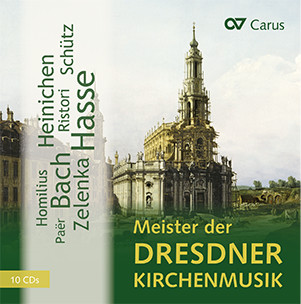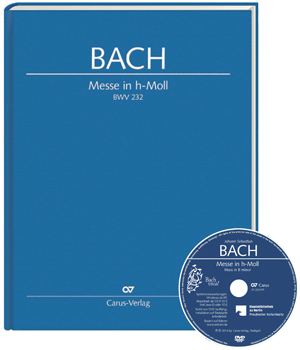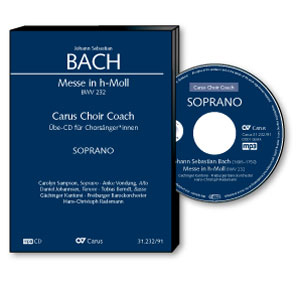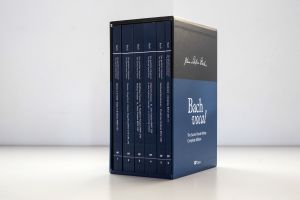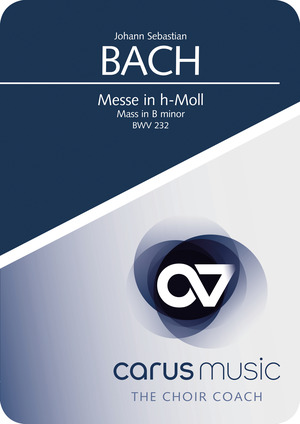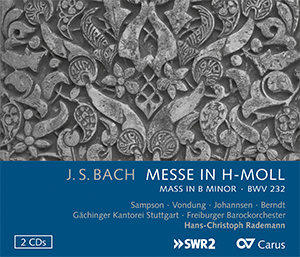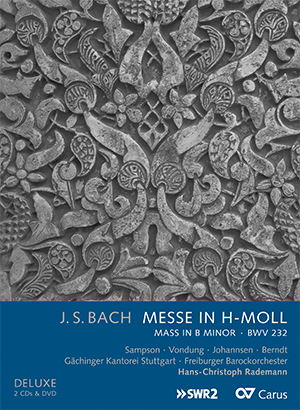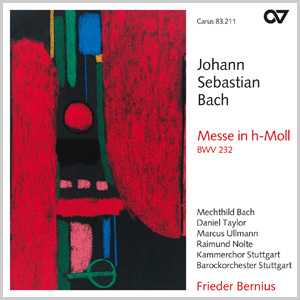
Johann Sebastian Bach B minor Mass
BWV 232 (BWV3 232.4)
- Scoring:
- Soli SSATB, Coro SSAATTBB, 2 Fl, 3 Ob (auch Obda), 2 Fg, Cor, 3 Tr, Timp, 2 Vl, Va, Bc
- Search for works with similar scoring
- Language:
- Latin
- Duration:
- 100 min
- Difficulty level:
- 1 2 3 4 5
 Listen
(27)
Listen
(27)
- Purchase the work as a CD or download.
- Kyrie eleison I
- Christe eleison
- Kyrie eleison II
- Gloria in excelsis Deo
- Et in terra pax
- Laudamus te
- Gratias agimus tibi
- Domine Deus
- Qui tollis
- Qui sedes
- Quoniam tu solus Sanctus
- Cum Sancto Spiritu
- Credo in unum Deum
- Patrem omnipotentem
- Et in unum Dominum
- Et incarnatus est
- Crucifixus
- Et resurrexit
- Et in Spiritum Sanctum
- Confiteor
- Et exspecto
- Sanctus / Pleni sunt
- Osanna
- Benedictus
- Osanna
- Agnus Dei
- Dona nobis pacem
 Practise
Practise
-
-
Practice aids voice part soprano
- Kyrie eleison I (Choir Coach, soprano 1)
- Kyrie eleison I (Choir Coach, soprano 2)
- Kyrie eleison II (Choir Coach)
- Gloria in excelsis Deo (Choir Coach, soprano 1)
- Gloria in excelsis Deo (Choir Coach, soprano 2)
- Et in terra pax (Choir Coach, soprano 1)
- Et in terra pax (Choir Coach, soprano 2)
- Gratias agimus tibi (Choir Coach)
- Qui tollis (Choir Coach)
- Cum Sancto Spiritu (Choir Coach, soprano 1)
- Cum Sancto Spiritu (Choir Coach, soprano 2)
- Credo in unum Deum (Choir Coach, soprano 1)
- Credo in unum Deum (Choir Coach, soprano 2)
- Patrem omnipotentem (Choir Coach)
- Et incarnatus est (Choir Coach, soprano 1)
- Et incarnatus est (Choir Coach, soprano 2)
- Crucifixus (Choir Coach)
- Et resurrexit (Choir Coach, soprano 1)
- Et resurrexit (Choir Coach, soprano 2)
- Confiteor (Choir Coach, soprano 1)
- Confiteor (Choir Coach, soprano 2)
- Et exspecto (Choir Coach, soprano 1)
- Et exspecto (Choir Coach, soprano 2)
- Sanctus / Pleni sunt (Choir Coach, soprano 1)
- Sanctus / Pleni sunt (Choir Coach, soprano 2)
- Sanctus / Pleni sunt (Choir Coach, soprano 1)
- Sanctus / Pleni sunt (Choir Coach, soprano 2)
- Osanna (Choir Coach, soprano 1)
- Osanna (Choir Coach, soprano 2)
- Dona nobis pacem (Choir Coach)
- Kyrie eleison II (Choir Coach, Slow mode)
- Gloria in excelsis Deo (Choir Coach, Slow mode, soprano 1)
- Gloria in excelsis Deo (Choir Coach, Slow mode, soprano 2)
- Et in terra pax (Choir Coach, Slow mode, soprano 1)
- Et in terra pax (Choir Coach, Slow mode, soprano 2)
- Gratias agimus tibi (Choir Coach, Slow mode)
- Qui tollis (Choir Coach, Slow mode)
- Cum Sancto Spiritu (Choir Coach, Slow mode, soprano 1)
- Cum Sancto Spiritu (Choir Coach, Slow mode, soprano 2)
- Credo in unum Deum (Choir Coach, Slow mode, soprano 1)
- Credo in unum Deum (Choir Coach, Slow mode, soprano 2)
- Patrem omnipotentem (Choir Coach, Slow mode)
- Et resurrexit (Choir Coach, Slow mode, soprano 1)
- Et resurrexit (Choir Coach, Slow mode, soprano 2)
- Confiteor (Choir Coach, Slow mode, soprano 1)
- Confiteor (Choir Coach, Slow mode, soprano 2)
- Et exspecto (Choir Coach, Slow mode, soprano 1)
- Et exspecto (Choir Coach, Slow mode, soprano 2)
- Sanctus / Pleni sunt (Choir Coach, Slow mode, soprano 1)
- Sanctus / Pleni sunt (Choir Coach, Slow mode, soprano 2)
- Sanctus / Pleni sunt (Choir Coach, Slow mode, soprano 1)
- Sanctus / Pleni sunt (Choir Coach, Slow mode, soprano 2)
- Osanna (Choir Coach, Slow mode, soprano 1)
- Osanna (Choir Coach, Slow mode, soprano 2)
- Dona nobis pacem (Choir Coach, Slow mode)
-
Practice aids voice part alto
- Kyrie eleison I (Choir Coach)
- Kyrie eleison II (Choir Coach)
- Gloria in excelsis Deo (Choir Coach)
- Et in terra pax (Choir Coach)
- Gratias agimus tibi (Choir Coach)
- Qui tollis (Choir Coach)
- Cum Sancto Spiritu (Choir Coach)
- Credo in unum Deum (Choir Coach)
- Patrem omnipotentem (Choir Coach)
- Et incarnatus est (Choir Coach)
- Crucifixus (Choir Coach)
- Et resurrexit (Choir Coach)
- Confiteor (Choir Coach)
- Et exspecto (Choir Coach)
- Sanctus / Pleni sunt (Choir Coach, Alto 1)
- Sanctus / Pleni sunt (Choir Coach, Alto 2)
- Sanctus / Pleni sunt (Choir Coach, Alto 1)
- Sanctus / Pleni sunt (Choir Coach, Alto 2)
- Osanna (Choir Coach, Alto 1)
- Osanna (Choir Coach, Alto 2)
- Gloria in excelsis Deo (Choir Coach, Slow mode)
- Et in terra pax (Choir Coach, Slow mode)
- Gratias agimus tibi (Choir Coach, Slow mode)
- Qui tollis (Choir Coach, Slow mode)
- Cum Sancto Spiritu (Choir Coach, Slow mode)
- Credo in unum Deum (Choir Coach, Slow mode)
- Patrem omnipotentem (Choir Coach, Slow mode)
- Et resurrexit (Choir Coach, Slow mode)
- Confiteor (Choir Coach, Slow mode)
- Et exspecto (Choir Coach, Slow mode)
- Sanctus / Pleni sunt (Choir Coach, Slow mode, Alto 1)
- Sanctus / Pleni sunt (Choir Coach, Slow mode, Alto 2)
- Sanctus / Pleni sunt (Choir Coach, Slow mode, Alto 1)
- Sanctus / Pleni sunt (Choir Coach, Slow mode, Alto 2)
- Osanna (Choir Coach, Slow mode, Alto 1)
- Osanna (Choir Coach, Slow mode, Alto 2)
- Dona nobis pacem (Choir Coach, Slow mode)
-
Practice aids voice part tenore
- Kyrie eleison I (Choir Coach)
- Kyrie eleison II (Choir Coach)
- Gloria in excelsis Deo (Choir Coach)
- Et in terra pax (Choir Coach)
- Gratias agimus tibi (Choir Coach)
- Qui tollis (Choir Coach)
- Cum Sancto Spiritu (Choir Coach)
- Credo in unum Deum (Choir Coach)
- Patrem omnipotentem (Choir Coach)
- Et incarnatus est (Choir Coach)
- Crucifixus (Choir Coach)
- Et resurrexit (Choir Coach)
- Confiteor (Choir Coach)
- Et exspecto (Choir Coach)
- Sanctus / Pleni sunt (Choir Coach)
- Sanctus / Pleni sunt (Choir Coach)
- Osanna (Choir Coach, Tenore 1)
- Osanna (Choir Coach, Tenore 2)
- Kyrie eleison II (Choir Coach, Slow mode)
- Gloria in excelsis Deo (Choir Coach, Slow mode)
- Et in terra pax (Choir Coach, Slow mode)
- Gratias agimus tibi (Choir Coach, Slow mode)
- Qui tollis (Choir Coach, Slow mode)
- Cum Sancto Spiritu (Choir Coach, Slow mode)
- Credo in unum Deum (Choir Coach, Slow mode)
- Et resurrexit (Choir Coach, Slow mode)
- Confiteor (Choir Coach, Slow mode)
- Et exspecto (Choir Coach, Slow mode)
- Sanctus / Pleni sunt (Choir Coach, Slow mode)
- Sanctus / Pleni sunt (Choir Coach, Slow mode)
- Osanna (Choir Coach, Slow mode, Tenore 1)
- Osanna (Choir Coach, Slow mode, Tenore 2)
-
Practice aids voice part basso
- Kyrie eleison I (Choir Coach)
- Kyrie eleison II (Choir Coach)
- Gloria in excelsis Deo (Choir Coach)
- Gratias agimus tibi (Choir Coach)
- Qui tollis (Choir Coach)
- Cum Sancto Spiritu (Choir Coach)
- Credo in unum Deum (Choir Coach)
- Patrem omnipotentem (Choir Coach)
- Et incarnatus est (Choir Coach)
- Crucifixus (Choir Coach)
- Et resurrexit (Choir Coach)
- Confiteor (Choir Coach)
- Et exspecto (Choir Coach)
- Sanctus / Pleni sunt (Choir Coach)
- Sanctus / Pleni sunt (Choir Coach)
- Osanna (Choir Coach, Basso 1)
- Osanna (Choir Coach, Basso 2)
- Dona nobis pacem (Choir Coach)
- Kyrie eleison II (Choir Coach, Slow mode)
- Gloria in excelsis Deo (Choir Coach, Slow mode)
- Et in terra pax (Choir Coach, Slow mode)
- Gratias agimus tibi (Choir Coach, Slow mode)
- Qui tollis (Choir Coach, Slow mode)
- Cum Sancto Spiritu (Choir Coach, Slow mode)
- Credo in unum Deum (Choir Coach, Slow mode)
- Patrem omnipotentem (Choir Coach, Slow mode)
- Et resurrexit (Choir Coach, Slow mode)
- Confiteor (Choir Coach, Slow mode)
- Et exspecto (Choir Coach, Slow mode)
- Sanctus / Pleni sunt (Choir Coach, Slow mode)
- Sanctus / Pleni sunt (Choir Coach, Slow mode)
- Osanna (Choir Coach, Slow mode, Basso 1)
- Osanna (Choir Coach, Slow mode, Basso 2)
- Dona nobis pacem (Choir Coach, Slow mode)
 Additional material
Additional material
- Purchase additional material as a download product.
-
 text (without music) for download, html file, Singing text, english translationhtml file, Singing text, english translation (Sample)
text (without music) for download, html file, Singing text, english translationhtml file, Singing text, english translation (Sample)I. Missa
Kyrie
1. Coro
Lord, have mercy on us.
2. Soprano & Alto
Christ, have mercy on us.
3. Coro
Lord, have mercy on us.
Gloria
4a. Coro
Glory be to God on high.
4b. Coro
And on earth peace to men of good will.
5. Soprano
We praise thee; we bless thee; we adore thee; we glorify thee.
6. Coro
We give thee thanks for thy great glory.
7a. Soprano & Tenore
Lord God, heavenly King, God the almighty Father.
O Lord, the only-begotten Son, Jesus Christ,
O Lord God, Lamb of God, Son of the Father.7b. Coro
... -
 text (without music) for download, html file, Singing text, German translationhtml file, Singing text, German translation (Sample)
text (without music) for download, html file, Singing text, German translationhtml file, Singing text, German translation (Sample)I. Missa
Kyrie
1. Coro
Herr, erbarme dich unser.2. Soprano & Alto
Christus, erbarme dich unser.3. Coro
Herr, erbarme dich unser.Gloria
4a. Coro
Ehre sei Gott in der Höhe.4b. Coro
Und Friede auf Erden den Menschen, die guten Willens sind.5. Soprano
Wir loben dich, wir preisen dich,
wir beten dich an, wir rühmen dich.6. Coro
Wir danken dir,... -
 text (without music) for download, html file, Singing text, originalhtml file, Singing text, original (Sample)
text (without music) for download, html file, Singing text, originalhtml file, Singing text, original (Sample)I. Missa
Kyrie
1. Coro
Kyrie eleison.2. Soprano & Alto
Christe eleison.3. Coro
Kyrie eleison.Gloria
4a. Coro
Gloria in excelsis Deo.4b. Coro
Et in terra pax hominibus bonae voluntatis.5. Soprano
Laudamus te, benedicimus te, adoramus te, glorificamus te.6. Coro
Gratias agimus tibi propter magnam gloriam tuam.7a. Soprano & Tenore
Domine Deus, Rex caelestis,
... -
 text (without music) for download, html file, Introductory text, Englishhtml file, Introductory text, English (Sample)
text (without music) for download, html file, Introductory text, Englishhtml file, Introductory text, English (Sample)Text from the CD Carus 83.314
Ulrich Leisinger
Translation (abridged): J. Bradford Robinson, David KosvinerThe idea of an autonomous work of art that has governed discussions of art ever since the nineteenth century was alien to Johann Sebastian Bach and his contemporaries. Almost all of Bach’s compositions were written for external occasions, whether in fulfillment of his duties as concert- and chapel-master or to meet the needs of his lessons. Remarkably, however, he returned to some of his works again and again over long periods of time. Some of the alterations he made went far beyond what was necessary for a simple revival, suggesting that he was intent on putting these works into a “definitive”shape.
The circumstances surrounding the Mass in B minor BWV 232, to use the name we give it today (Carl Philipp Emanuel Bach called it “the great Catholic Mass” to distinguish it from his father’s Kyrie-Gloria Masses, BWV 233–236), are especially complex. Its genesis was spread over a period of more than fifteen years, and the work, though finished at the time of Bach’s death (on 28 July 1750), still awaited a final revision to put it into performable condition. Despite
... -
 text (without music) for download, html file, Introductory text, Germanhtml file, Introductory text, German (Sample)
text (without music) for download, html file, Introductory text, Germanhtml file, Introductory text, German (Sample)Booklet-Text der CD Carus 83.314
Ulrich Leisinger
Die Idee des autonomen Kunstwerks, die die Diskussion von Kunst seit dem 19. Jahrhundert bestimmt, war Johann Sebastian Bach und seinen Zeitgenossen fremd. Nahezu alle Kompositionen Bachs sind auf äußere Veranlassung hin entstanden, sei es aus seinen Dienstpflichten als Konzert- und Kapellmeister oder aus der Notwendigkeit des Unterrichts heraus. Bemerkenswert ist aber, dass er sich mit einigen seiner Werke über größere Zeiträume immer wieder auseinandergesetzt hat. Die Eingriffe, die er dabei vornahm, gingen zum Teil deutlich über das hinaus, was für eine bloße Wiederaufführung notwendig gewesen wäre, und lassen ein Bemühen erkennen, eine „endgültige“ Werkgestalt zu schaffen.
Besonders komplex sind die Verhältnisse bei der h-Moll-Messe BWV 232, wie wir sie heute nennen (Carl Philipp Emanuel Bach nannte sie in Abgrenzung von den Kyrie-Gloria-Messen BWV 233–236 „die große catholische Messe“), denn ihre Entstehungsgeschichte erstreckt sich über einen Zeitraum von mehr als 15 Jahren, und das Werk war zum Zeitpunkt des Todes von Johann Sebastian Bach am 28. Juli 1750 zwar
...
Contents
-
Composer
Johann Sebastian Bach
| 1685-1750Johann Sebastian Bach is one of the most important composers of Western music history. He came from a widely ramified musical dynasty, which produced numerous musicians and organists in the Thuringian-Saxon area.
Bach vocal
Ever since Carus-Verlag was founded in 1972, publishing the music of Johann Sebastian Bach has been a special focus for us. In the 2017 Reformation anniversary year we completed the Bach vocal project. Bach's complete sacred vocal works are now available in modern Urtext editions, together with performance material. A complete edition of all the full scores is also available in a high quality box set. Personal details
-
Preface writer
Uwe Wolf
| 1961Uwe Wolf studied musicology, history, and historical ancillary science at Tübingen and Göttingen. After receiving his doctorate in 1991 he was a research assistant at the Johann-Sebastian-Bach-Institut in Göttingen. From 2004 he worked at the Bach-Archiv Leipzig. There he directed a both research departments, was substantially responsible for the redisigning of the Bach Museum, and he developed the digital Online-Projekt Bach. Since October 2011 he has been the Chief Editor at Carus-Verlag, Stuttgart. He has taught at various universities and also belongs to the editorial boards of several complete editions. Personal details
-
Choir
Kammerchor Stuttgart
The Kammerchor Stuttgart is regarded as one of the best ensembles of its kind. Over its fifty-year existence, Frieder Bernius has developed the choir into an exceptional ensemble acclaimed by audiences and press alike. This has led to invitations for the choir to perform at all the important European festivals. In Germany the chamber choir performs at festivals and in concert halls in repertoire ranging from the 17th to the 21st century. Frieder Bernius and his ensemble have received numerous accolades for their contribution to new music. The Kammerchor Stuttgart has made over 80 CDs and LPs, numerous of which have been awarded international recording prizes (including the Edison award, Diapason d’or, Gramophone Choice, Classical Internet Award, International Classical Music Award, and German Record Critics’ Award prizes). The International Federation for Choral Music has invited the ensemble to sing at the 1st, 4th and 10th World Symposia on Choral Music in Vienna, Sydney and Seoul. Regular tours of North America and Asia since 1988 and a South America tour reflect the Kammerchor Stuttgart’s international reputation. Since 1984 the top ensemble has also been invited to Israel biennially. Personal details
-
Orchestra
Barockorchester Stuttgart
The Barockorchester Stuttgart, which was founded by Bernius in 1985, specializes in 18th century music. The musicians are among the leading representatives of historical performance practice and perform exclusively on original instruments. The ensemble dedicates itself to a large extent to the revival of 18th century operas. It has performed at numerous international festivals, among others in Rome, Dresden and Göttingen. Personal details
-
Conductor
Frieder Bernius
| 1947Frieder Bernius’s work has earned great worldwide recognition. He is in demand internationally as a conductor and as a teacher. His principal artistic collaborators are the ensembles he founded himself, the Kammerchor Stuttgart, the Barockorchester Stuttgart, the Hofkapelle Stuttgart and the Klassische Philharmonie Stuttgart. As a guest conductor, he has collaborated repeatedly with, for example, the SWR Vokalensemble Stuttgart, the Deutsche Kammerphilharmonie Bremen, the Stuttgarter Kammerorchester and the Streicherakademie Bozen. Great stylistic versatility is Frieder Bernius’s hallmark. Whether he conducts vocal works by Monteverdi, Bach, Händel, Mozart, Beethoven, Fauré and Ligeti, stage music by Mendelssohn or symphonies by Haydn, Burgmüller and Schubert, his work always aims for a sound that is at once unmistakably personal and at the same time oriented towards the original period sound ideal. He devotes himself equally to the rediscovery of 18th century operas and to first performances of contemporary compositions. He is particularly interested in the musical history of southwestern Germany. Carus-Verlag has awarded Frieder Bernius a Golden CD for his complete recording of the sacred music of Felix Mendelssohn Bartholdy. The award was presented to him during the German Choir Festival in Stuttgart 2016. The sale of over 250,000 recordings, which has been acclaimed with a number of awards, has made a not insignificant contribution to what today is the obvious presence of Mendelssohn's complete œuvre in the concert repertoire. Personal details
-
Soloist - soprano
Mechthild Bach
The soprano Mechthild Bach was born in Limburg/ Lahn and studied singing with Elsa Cavelti at the Frankfurt Musikhochule. She also studied under Elisabeth Schwarzkopf, Laura Sarti and Vera Rosza. From 1986 she was the recipient of a grant from the German National Studies Foundation (SDV). Opera engagements took her to various German theaters where she mastered a broad repertoire as a lyric soprano. As a concert singer, Mechthild Bach regularly collaborates with renowned artists and ensembles throughout Europe. Her artistic achievements are preserved on numerous radio and CD recordings. A recording of Zelenka’s Missa Dei Patris in which she was a soloist was awarded the German Record Critics’ Prize in 2002. Personal details
-
Soloist - alto
Daniel Taylor
Daniel Taylor is one of the most sought-after countertenors worldwide. He performs with numerous international ensembles and symphony orchestras. As a recitalist, he has performed in the Konzerthaus Vienna, at the Frick Collection New York, in the Forbidden Concert Hall Beijing, Lufthansa Baroque Festival and Wigmore Hall London. He appeared in Jeremy Podeswa’s prize-winning film Five Senses. As an opera singer he has performed at Glyndebourne (Handel’s Theodora), the Metropolitan Opera New York (Handel’s Giulio Cesare), the Bavarian State Opera (Handel’s Rinaldo), Edinburgh (Gluck’s Orfeo), Welsh National Opera (Handel’s Jephtha) and the Canadian Opera (Handel’s Tolomeo). Daniel Taylor studied literature, music and philosophy before studying completing his exams in music and religious studies at the University of Montreal. Daniel Taylor is a professor at the Conservatoire de musi que in Montreal. Personal details
-
Soloist - tenor
Marcus Ullmann
-
Soloist - bass
Raimund Nolte
The baritone Raimund Nolte received his formative training as a singer from Josef Metternich and is currently coached by Irmgard Hartmann. He has appeared in concerts throughout Europe and in Israel, Japan and the USA. His stage debut at the Innsbruck Festival in 1994 was followed by permanent engagements at the Deutsche Oper am Rhein, Theater Bielefeld and, from 1996, the Komische Oper Berlin. Besides focusing on Handel and the major Mozart roles, Raimund Nolte has devoted himself in particular to lyrical and “cavalier” roles. He has been invited to sing in major European concert halls, in Upper Italy and in a concert series with the Israeli Kibbutz Orchestra. Personal details
Reviews
Bernius, Messe in h-Moll
![]()
Schlicht und andachtsvoll mit plötzlichen Zügen von Exaltiertheit: so könnte man vereinfachend den Eindruck zusammenfassen, den diese Einspielung der h-Moll-Messe durch Frieder Bernius vermittelt. Dieser große Chorleiter, dessen Nähe zu Bach offenkundig ist (seine Einspielung der Motetten beherrscht die Diskographie), hat lange gewartet, bevor er die Einspielung des ökumenischen Hauptwerks des Kantors in Angriff nahm. Ablehnung von Effekthascherei, lutherische Strenge, sparsamer jedoch fühlbarer Ausdruck von Emotionen: Bernius möchte uns nicht durch ein Monument einschüchtern, im Gegenteil, er sucht hinter den Chören (Gloria und Credo besonders zurückhaltend) und im Verlauf der Arien (alle sehr feinsinnig wiedergegeben) eine Menschlichkeit und Spiritualität möglichst nahe an Christi Botschaft ebenso wie an aufrichtigen und demütigen Gläubigen. Darum wirkt die kraftvolle Freude des Resurrexit und der beiden Osanna umso herausstechender. Diese Subtilität könnte diejenigen stören, die beeindruckt werden wollen (ob sie nun Klemperer, Gardiner oder Harnoncourt hören) oder nur in ihrer Seele bewegt werden wollen (diesen lägen Leonhardt oder Brüggen eher), diejenigen jedoch, die eine h-Moll-Messe auf der Höhe des Menschen suchen, werden erfreut sein.
Quelle: Diapason
[...] Wer immer eine neue Aufnahme der Messe vorlegt, muss wissen, was er tut - hier gelten höchste Ansprüche und Maßstäbe. Voilà: Genau das Richtige für Frieder Bernius und seinen formidablen Kammerchor Stuttgart.
Bevor ein weiteres Wort gesagt ist: Eine klangschönere, virtuoser gedachte und in aller Fülle transparentere Aufnahme wird man auf dem satten Markt nicht leicht finden. Wenn nicht alles täuscht, schmiegt sich der Anspruch von Frieder Bernius jenem Bachschen Gedanken eng verfugt an: Ein Künstler zieht die Summe jahrzehntelanger Arbeit.
[...]
Man darf also, man muss sogar mit geschärftem Ohr hören, denn anderes würde der Sache nicht gerecht. Und dies ist das Tableau: Vier ausgesuchte Solisten, die nach Art und Ausprägung ihrer stimmlich-musikalischen Individualität für gemeinschaftliche Leistungen prädestiniert sind; 28 Choristen von virtuoser Stimmbeherrschung, selbstverständlich allesamt handverlesen; dazu ein vorzüglich besetztes Barockorchester, das dem Kammerchor ebenbürtig agiert (was wahrhaftig etwas heißen will) - schließlich die Akribie des tüftelnden Aufnahmekünstlers Bernius in der heil'gen Halle der geliebten Kirche in Gönningen. Alle Voraussetzungen stimmen.
Quelle: ndrkultur.de, 18.12.06
[...] Die h-Moll-Messe gilt trotz ihrer ungewöhnlichen Entstehungsgeschichte als musikalisches Vermächtnis. In genialer Weise gelingt es Bach, Sätze von ganz unterschiedlicher stilistischer Grundsubstanz nebeneinander zu stellen, ohne jemals die Geschlossenheit des Ganzen zu gefährden. [...] Nicht nur Bach, auch Frieder Bernius, sein Kammerchor und das Barockorchester Stuttgart ziehen mit dieser Einspielung die Summe jahrzehntelanger Arbeit. Und das Ergebnis kann sich hören lassen. [...] Die Aufnahme erfreut durch einen außerordentlich homogenen Chorklang und ein mit Akribie musizierendes Barockorchester. [...] Frieder Bernius teilt seine 28 Choristen und sein auf historischen Instrumenten spielendes Orchester und lässt es jubeln mit schlankem Ton, deutlichem Akzent und rhythmischer Perfektion.
Kerstin Herfricht
Quelle: hr2, CD-Tipp für „Klassik-Zeit“, 18.12.06
This musical setting of the Latin Mass by Johann Sebastian Bach is one of the greatest and most popular musical works ever written. […] This fine recording by Frieder Bernius with the Kammerchor Stuttgart and the Barockorchester Stuttgart, which is admirably based on the principles of historical performance practice, brings out all the musical details and the grand scale of Bach's awesome creation. […]
Quelle: new-classics.co.uk, 21.12.06
[...] Da ist zunächst einmal die Wahl, der Tempi, die von Anfang bis Ende ungemein durchdacht, durchgehört und empfunden sind. - bis hin zu dem eigenartigen Moment des „Et ressurexit”, das deshalb so unglaublich schnell genommen scheint, weil der Vorgang selbst, von dem hier die Rede ist, ja auch etwas „unglaubliches” ist. Restlos begeisterte mich auch die Gestaltung der heiklen Übergänge: Was sonst gern als Sollbruchstelle empfunden wird - die Einsätze des „Et in terra” im Gloria etwa oder des „Expecto” im Credo -, das ist hier mit Bedacht (nicht: bedächtig!) und beispielhafter Behutsamkeit, unter Verzicht auf jedes pseudo-exegetische Geschmachte, realisiert worden. Wie weit das gehen kann, zeigt schließlich das Agnus Dei, durch das ohne die geringste Neigung zum Verschleppen der schmerzlich-schwerfällige Gang zur Schädelstätte den Takt vorgibt. [...]
Quelle: klassik-heute.de, 01/2007
[...] Die in diesem trockenen Klang entstehende Transparenz der einzelnen Stimmen verleiht der Musik eine kühle Atmosphäre, die [...] sich wunderbar in die kalvinistisch-protestantische Kirchenatmosphäre fügt. [...]
Thomas Richter
klassik.com, 07.02.2007
Reviews on our website can only be submitted by customers with a registered user account. A check whether the rated products were actually purchased does not take place.
Frequent questions about this work
 There are no questions and answers available so far or you were unable to find an answer to your specific question about this work? Then click here and send your specific questions to our Customer Services!
There are no questions and answers available so far or you were unable to find an answer to your specific question about this work? Then click here and send your specific questions to our Customer Services!


